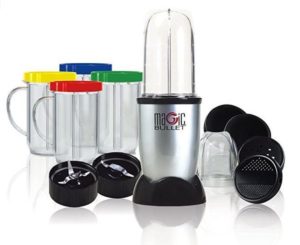
Produce is one of those “halo” foods that truly deserves a halo. Fruits and veggies are rich in fiber, nutrients, phytochemicals, and antioxidants that have been shown to fight everything from heart disease, cancers and stroke to diabetes and poor vision. Yet, according to the Centers for Disease Control and Prevention (CDC), only 1 out of 10 adults are consuming the recommended minimum 2 1/2 cups of veggies and 2 cups of fruit daily. Since the leaf doesn’t fall too far from the tree, it shouldn’t be surprising that kids are also coming up short in the produce-eating department.
So what’s the problem? The latest survey by the International Food Information Council (IFIC) suggests that one of the barriers to consuming Mother Nature’s finest is time, or in this case, lack of it. Many of us are looking for the fastest way to get dinner on the table, and the extra time to whip up plant-based side dishes, especially salads, have caused them to be chopped from the menu.
I feel your slicing and dicing pain so I have reached out to my registered dietitian nutritionist (RDN) pals for the produce gadgets that they use to help them and their families eat better in less time. My personal favorite is a Salad Slicer Bowl and Colander combo. All you have to do is put the lettuce and veggies in the slotted colander, rinse them under running water, invert the colander on its stand, and with a big knife, slice through the slots in the colander to dice your salad all at once. Since research shows that eating a salad prior to a meal can help curb your appetite, it’s a gadget I use daily to better manage my weight.
Here are the fruit and veggies gadgets that other RDNs use:
Joy Bauer, the host of NBC’s new show, Health + Happiness, and also the nutrition expert for the TODAY Show, uses an immersion blender to make creamy vegetable soup without adding any heavy cream. This hand held blender saves time by quickly pureeing the cooked veggies and thickening the soup in the pot without having to waste time transferring batches into a stand- alone blender. The end result is a creamy soup that’s low in calories, packed with filling fiber, and chock-full of vitamins and minerals.
Maye Musk, RDN, did such a good job making sure that her children devoured tons of produce when they were growing up, that her son, Kimbal (also brother of Elon Musk), started the Big Green. This non-profit organization funds and installs vegetable and fruit gardens in schools. Musk family’s favorite gadget is the Magic Bullet, which is an easy device that the kids can use to quickly make veggie and fruit smoothies from their garden bounty.
Kathleen Zelman, director of Nutrition at WebMD, looks to the spiralizer to twirl vegetables into the shape of spaghetti. She then adds these strands of veggies to pasta dishes to beef up the produce. Believe it or not, according to Zelman, kids love the shape of the veggies so often that they ask for seconds.
Toby Amidor, author of The Easy 5-Ingredient Healthy Cookbook, couldn’t live without a lightning-fast, vegetable chopper. According to Amidor, chopping veggies too far in advance can destroy some of the flavor and vitamins due to oxidation. She and her daughter tag-team in the kitchen and use this gadget to quickly add tons of vegetables to soups, salads, and main dishes.
Amy Gorin hates food waste so much that she uses strawberry huller to remove the stem rather than cutting off the entire top of the strawberry and tossing out a good chunk of the fruit with it. One cup of hulled strawberries provides close to 100 percent of the daily value for immunity-boosting vitamin C.
Keri Gans, author of The Small Change Diet grew up using an apple and pear cutter and is still using it daily. Gans finds it easier and more enjoyable to eat the small wedges of fruit versus biting into them whole but doesn’t want to spend time cutting portions using a knife. Apples and pears are good sources of fiber, and with a tablespoon of a nut butter, make a perfect filling snack.
This article originally appeared in The Boston Globe.